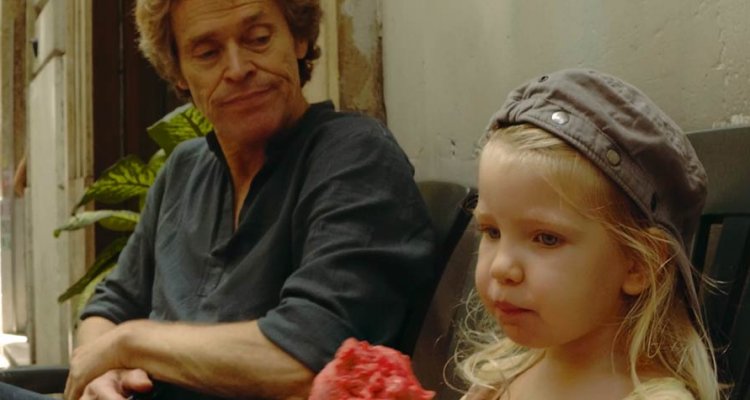Can fiction be a more powerful vehicle to express one’s lived experience than the documentary form? In the late period of his career, “Bad Lieutenant” director Abel Ferrara has become unexpectedly introspective, in part a consequence of his difficulty in financing ambitious projects. “Tommaso“—premiering as a Special Screening at the Cannes Film Festival—is the director’s first “fiction” effort since 2014 but undoubtedly an extension of his nonfiction work in recent years. Ferrara casts his wife and children in key roles in parallel roles, and the narrative about a filmmaker in Rome is a thinly-veiled take on his current situation. Unfortunately, “Tommaso” is far more navel-gazing and long-winded than intimate, in as much of a creative funk as its protagonist.
READ MORE: 2019 Cannes Film Festival: The 21 Most Anticipated Movies
Willem Dafoe plays the Tommaso of the film’s title, who lives with his wife Nikki and 3-year-old daughter DeeDee (Cristina Chiriac and Anna Ferrara, Ferrara’s real-life spouse and child) in the Italian capital. A film director by trade, his day-to-day routine includes facilitating an acting studio and attending support group meetings for addict expats. All the while Tommaso is developing his next feature project, one which bears a resemblance to Ferrara’s own long-gestating “Siberia.”
READ MORE: the 100 Most Anticipated Films Of 2019
Although “Tommaso” frames itself as a film about the inner workings of an artist—bearing a resemblance to Ferrara’s previous fiction effort, the far more creatively successful biopic “Pasolini”—it is far more invested in portraying the breakdown of the principal character’s marriage. The marital disintegration is clunky, to be sure, made shrill by plenty of shouting and hysteria on both their parts. Tommaso professes great love for his partner but treats her unambiguously as his possession. On the flip side, Nikki is an enigmatic presence seen only through her husband’s gaze, and it doesn’t help that Chiriac is stiff and unnatural on-screen presence.
READ MORE: Summer Movie Preview: 35 Films You Shouldn’t Miss
During one of the AA meetings, a man observes the “selfish, self-centered nature of his problem.” By permitting other people to tell their stories, these support group scenes are the most generous in a film which is profoundly narcissistic by default, As an insight into Ferrara’s creative process, “Tommaso” doesn’t have a great deal to offer. Dreams sequences are dominated by existential ramblings and sexual frustration that is difficult to decode.
READ MORE: The 25 Best Films Of 2019 We’ve Already Seen
In its own grimy way, “Tommaso” glamorizes the life of its subject by rendering it in scuzzy Ferrara-scope. Shot by Werner Herzog regular Peter Zeitlinger, the whole film is awash in a dingy yellow pallor. To be blunt, it’s an ugly movie and in a far less interesting way than grindhouse classics “The Driller Killer” and “Ms. 45” or his bigger-budgeted work of the 1990s. Best known for his depictions of New York City in its seedier days, Ferrara’s vision of his adopted home Rome is equally intimate and lived-in. Far from a tourist depiction of the city, Tommaso circulates exclusively in the alleyways and parks of his neighborhood as if an invisible tether bonds him to his apartment and his family.
Tommaso’s relationships with women are crude and old-fashioned—you have to wonder whose ego is being stroked when the fictional director draws the romantic interest of the nubile actresses in his workshop. These women often appear in the fantasy passages, and Ferrara’s objectifying framing of the female body is distasteful and clumsily ignorant of the current cultural conversation. It’s also difficult to swallow the character’s overstated devotion to his family; his daughter is regularly referred to in conversation as “the baby.”
The always-watchable Datoe makes the most of what he’s given in the title role of Tommaso. The actor’s gravelly tones are well-suited to capture the voice of the character’s hard-lived inspiration. As a body double for Ferrara, there’s a high degree of idealization in the casting of his longtime collaborator. A scene in which a nearly-naked Tommaso practices yoga—his lean, vascular physique pronounced—is far removed from Ferrara’s current image, so prominent in his late-period documentaries.
In the last 20 minutes of the Cannes press screening, a spectator entered, likely to a high degree of confusion about the narrative. At this juncture, the protagonist is sat at a campfire with strangers and pulls his still-beating heart out from his chest. From her perspective, “Tommaso” might seem like a thrilling, fantastical portrait of an artist, but Abel Ferrara’s execution is far less impactful image than the above description would suggest. The director remains adrift in the wasteland of the imagination. [C-]

